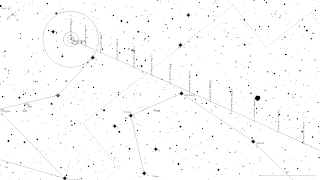Saturday, November 02, 2013
Comet C/2012 S1 ISON brightens,1-8 November 2013
Comet C/2012 S1 ISON has now been reported to be (just) visible in 10x50 binouclars. Currently somewhere around magnitude 8, with the Moon gone from the morning sky it visible in small scopes and strong binoculars. In binoculars it should look like a faint, fuzzy dot. However, its fuzzy, diffuse nature, its closeness to the horizon (between 7 -12 degrees depending on where you are, except Darwin and Far North Queensland, where it is more like 20 degrees above the horizon see here for charts illustrating the difference at different sites) means that it can be difficult to spot visually in smaller scopes.
If all goes well by the 8th it should be magnitude 7, and easily seen in binoculars.
The comet is to the right of Mars, making finding it relatively easy. The best time to look for it is when it is highest in the sky and the sky is darkest. However, especially in the Southern States, because it never gets very high, the best time to look is astronomical twilight. Astronomical twilight is an hour and a half before local sunrise.
On November 1 the comet is in the
constellation of Leo, and is just crossing Earth's Orbit (see image above). At this time comet
ISON is just under a hand span above the horizon as seen from the latitude of
Melbourne, just over a hand span as seen from the latitude of Sydney, nearly
two hand spans as seen from the latitude of Brisbane and almost 4 hand spans as
seen from the latitude of Darwin. A hand-span is the distance across your knuckles when your hand is outstreached at the end of your arm as if making a "stop" sign.
On the 1st there are no bright stars near
the comet. However, bright Mars is nearby and very
obvious. If you start at orange Mars and sweep down diagonally to the right
(east) of Mars around a hand span (the distance across the palm of your hand as
you hold it out at arm’s length like you are making a stop sign), the first
brightish star you come to is Chi (χ) Leo, down another 4 finger widths is the
next bright star, Sigma (σ) Leo (see the black and white printable map or the PDF map for this to be clearer).
The comet is roughly in between them, you may
need to hunt back and forth a bit to find it.
Over the next few days the comet
approaches, then passes, Sigma Leonis, being closest on the 3rd. Sweeping down again diagonally a little
over a hand span from Sigma Leonis is the bright star Zanijava, Beta (β) Virginis.
The comet approaches beta Virginis and is closest on the 7th and 8th of
November. The comet should, all things going well, be easily visible in
binoculars now.
A printable PDF map is here.
Labels: binoculars, C/2012 S1 ISON, comet, telescope







 Click to read about or order
Click to read about or order Click to read about or order
Click to read about or order Click to read about or order
Click to read about or order Click to read about or order
Click to read about or order




